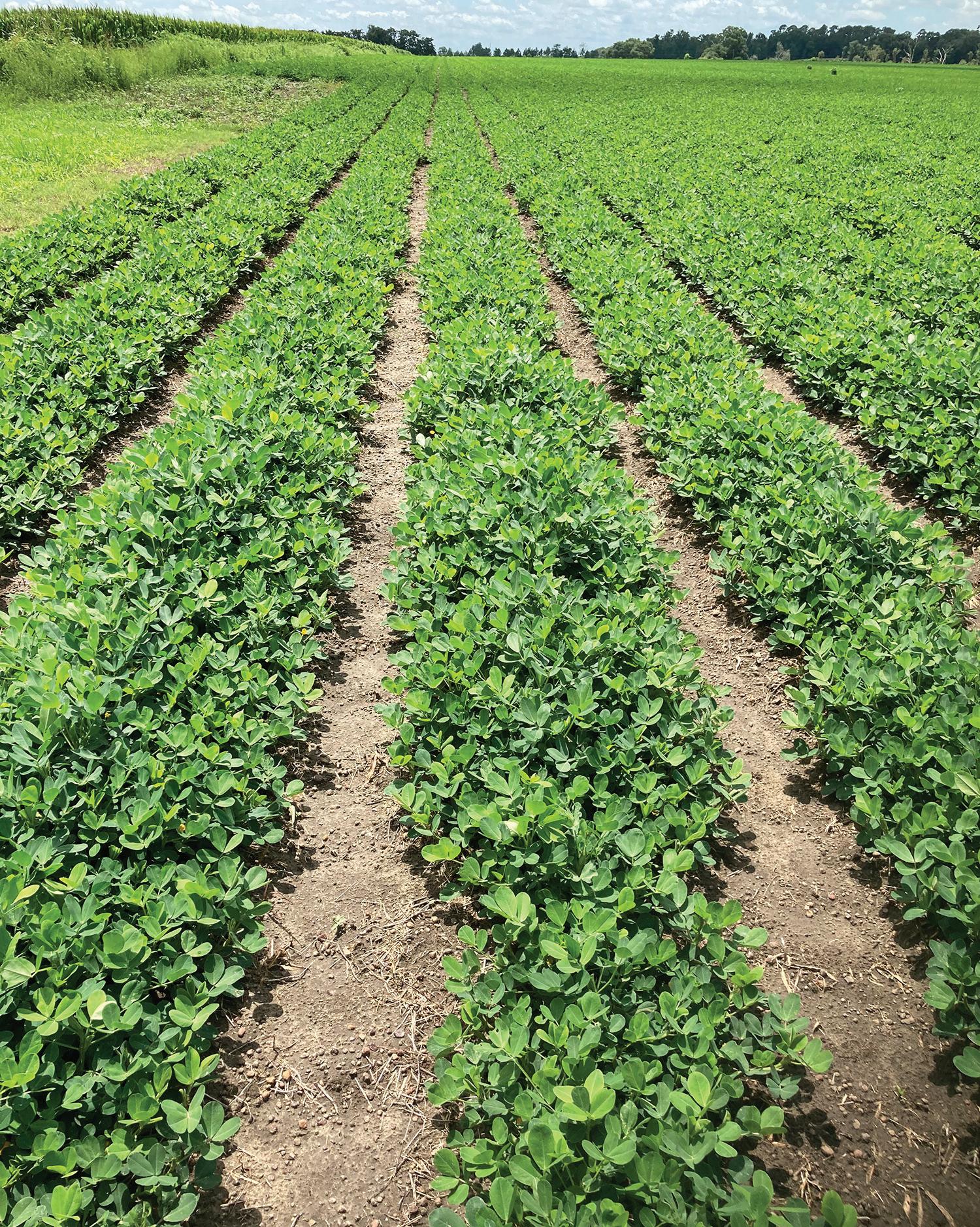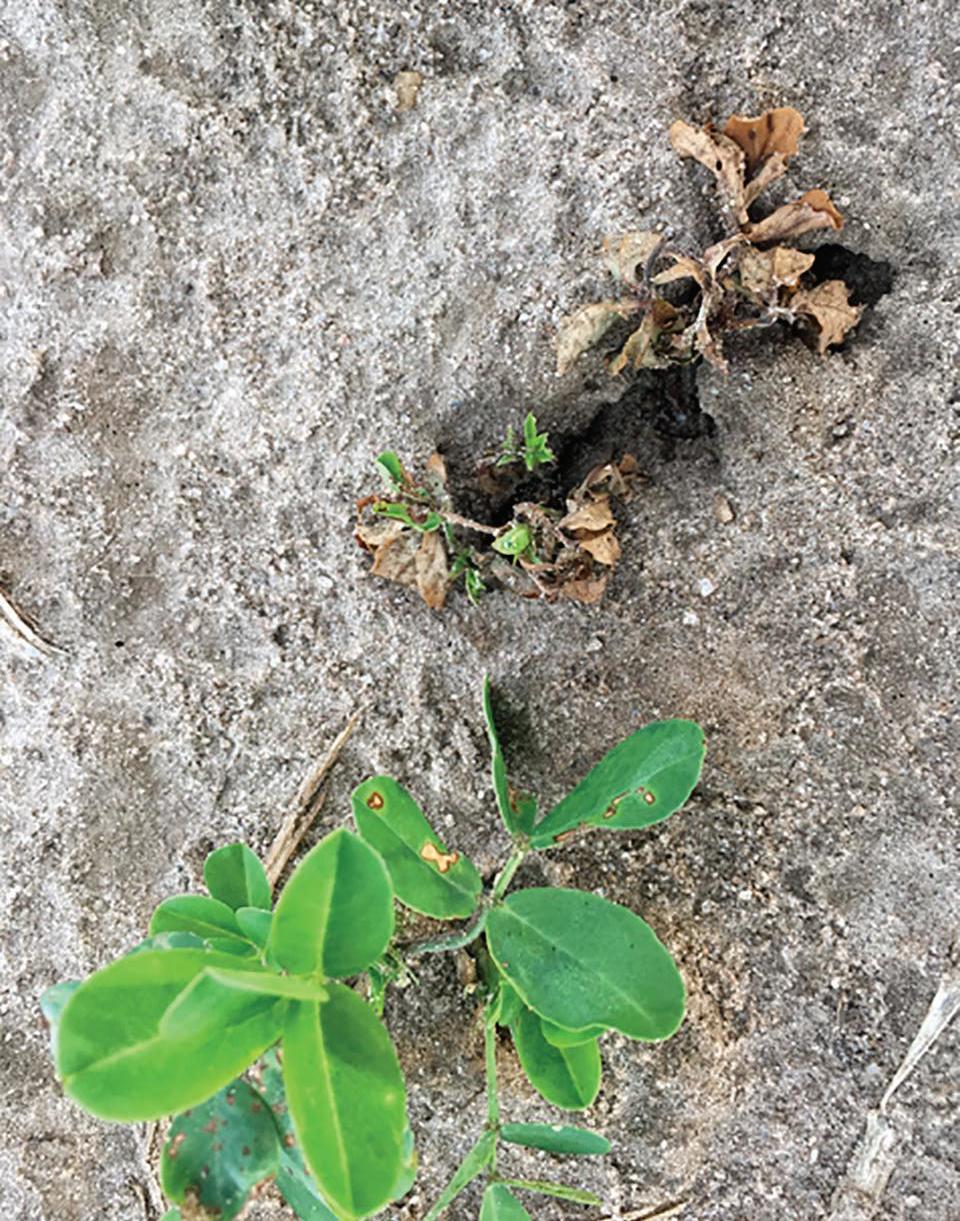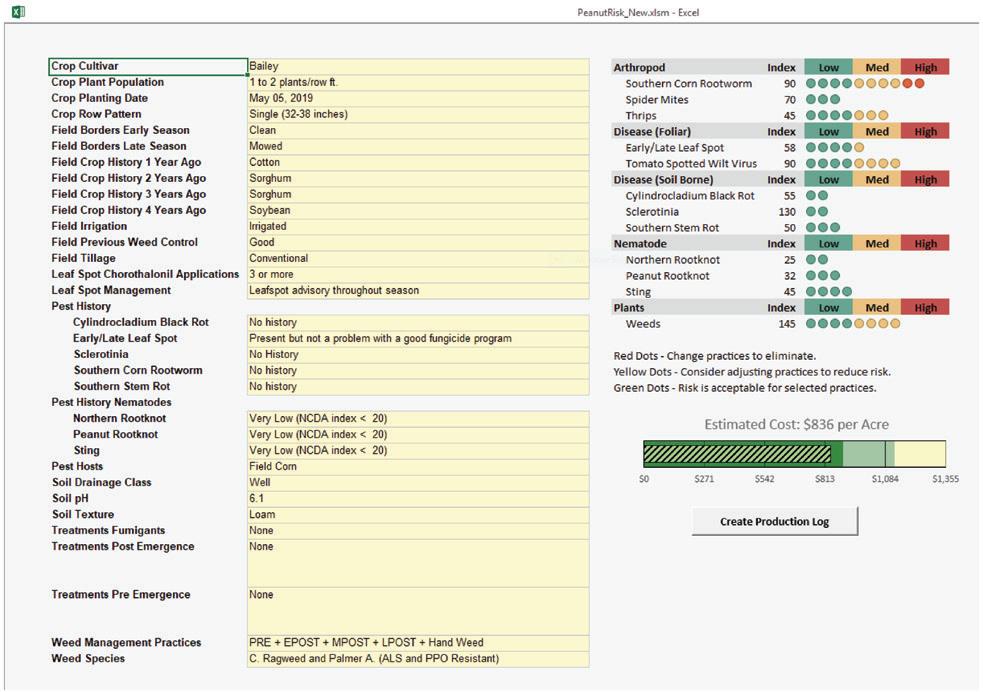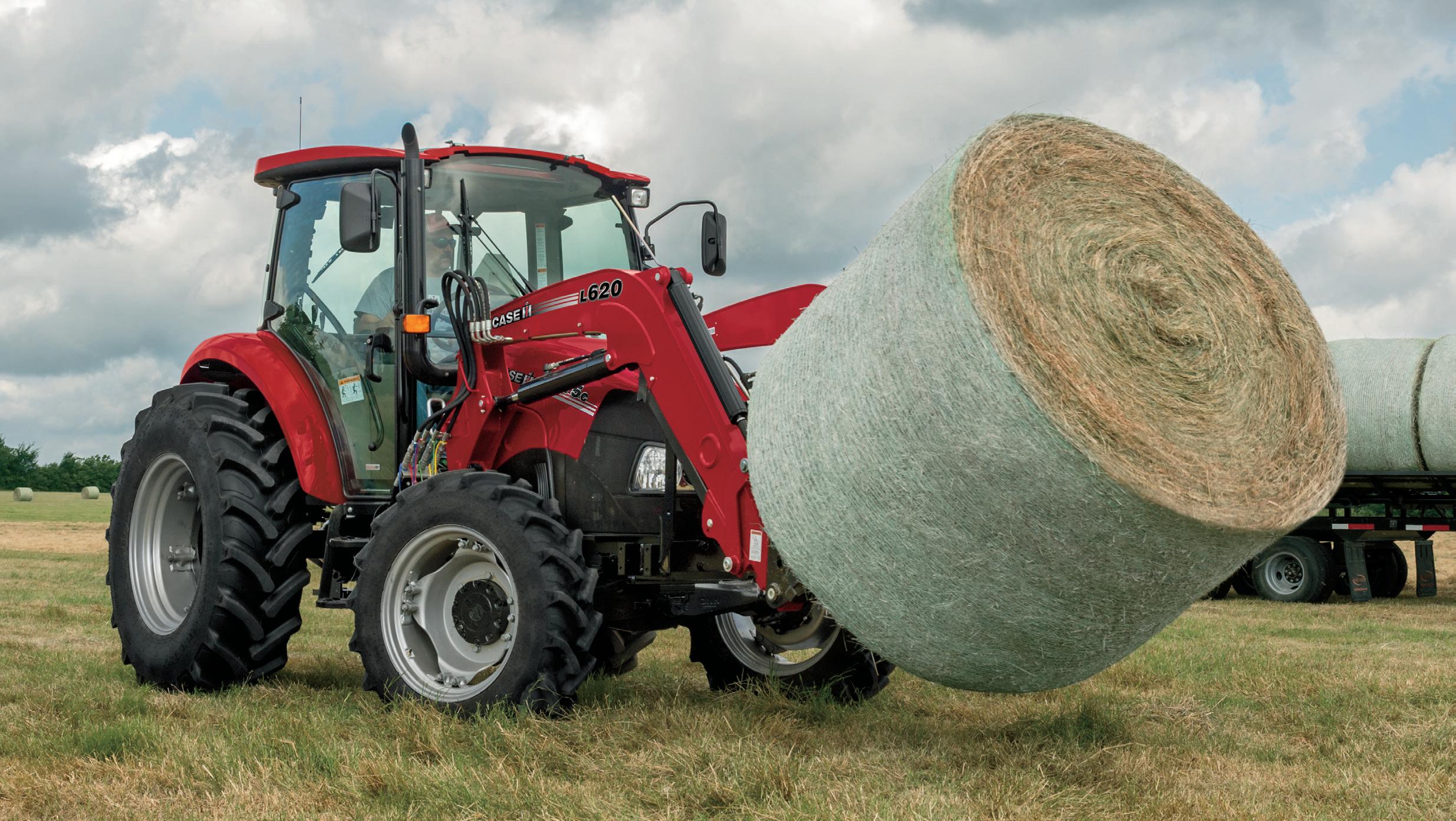
13 minute read
A ‘Swiss Army Knife’ Approach
Why not tackle as many problems as possible from the get-go?
Emergence and seedling vigor are critical to a successful crop. Getting over the first hurdle of pest pressure is also crucial for achieving good yields. Those early season problems include both nematodes and thrips.
Timing and waiting on the proper soil temperatures, plus special attention to what is added in the furrow at planting will help the crop get its best possible start. Uniformity and quick canpy coverage will shade the ground for developing pegs, but it all starts with planting and selecting in-furrow pest products.
Too Early Can Lose The Advantage
“You can stack it up any way you want, but the earlier you try to plant a peanut, the more problems you’re likely to encounter,” says Jack Royal, crop consultant in Leary, Georgia. “You want that plant to pop out of the ground as quickly as possible and roar off to a good start. You can’t do that when soil temperatures are too low — sometimes even if the temperatures are marginal.
“If you get a cold snap immediately after planting, there’s a good chance you’ve lost any advantage you thought you had by itching to get that planter in the field.”
Royal says he hopes no peanuts hit the furrow until soil temperatures are at least 70 degrees or higher. “Anything sooner than that, you might as well be playing blackjack,” he says. “You might get lucky, but they don’t build those casinos on a house of cards. They build them on statistics and years of research.”
Manage Multiple Problems At Once
While some growers balk at the price of AgLogic aldicarb, Royal says it’s worth the investment.
“AgLogic aldicarb has made a significant difference in our ability to produce cotton and peanuts,” he says. “The seed treatments have lost effectiveness due to resistance.
“Most of my cotton growers use standard seed from the manufacturer if they put aldicarb under their cotton. That saves them about $18 to $20 an acre, which goes toward AgLogic. We’re back to a better place for managing nematodes, thrips, spider mites and other early season pests.
“Peanuts are similar. Most of the same problems found in cotton are also in peanuts.”
Take The Worry Out Of Early Pest Pressure
Blakely, Georgia, grower Sam Hattaway agrees. “Thrips and aphids are always an obvious concern,” he says. “Using AgLogic comes with the added advantage of nematode control. Other options to control nematodes are expensive.”
AgLogic aldicarb applied in furrow on peanuts is registered at 7 pounds per acre at planting and 10 pounds per acre post-emergence. All applications should be incorporated into the soil.
“It’s been very good for us,” Hattaway says. “It takes a lot of worry out of the early season pest pressures, so we can deal with other problems that always seem to pop up.”
Picking Up Where It Left Off
It’s not particularly easy to reinstate a research initiative after a product like aldicarb has been off the market for five years. In addition to a new name, growers, consultants and researchers have questions about why they are even interested in a product that has been around for more than four decades. Turns out, the answer is similar to what it was in the ’70s.
“Even before I arrived, aldicarb has been a consistent performer in our trials early in the season for years to control
Dan Anco, Clemson University Extension peanut specialist, says early closing of rows to shade the ground for developing pegs is an important step to a successful peanut crop.
thrips injury,” says Dan Anco, Extension peanut specialist with Clemson University’s Edisto Research and Education Center in Blackville, South Carolina. “Early closing of the rows and shading the ground for developing pegs are important steps to encouraging success of a peanut crop.”
A Consistent Performer
Across any peanut growing area, researchers and Extension personnel have consistently evaluated the value of in-furrow pesticide applications for decades.
“AgLogic is extremely effective against thrips in peanut, and our research shows that early season thrips injury does reduce yield,” says Mark Abney, University of Georgia Extension entomologist.
The Benefits Of In-Furrow Pest Protection
As planting ramps up, growers are still considering their options.
“While aldicarb has long been considered the ‘swiss army knife’ of crop management, its value has not remained static,” says Lee Hall, AgLogic Chemical Co. vice president of business development in Chapel Hill, North Carolina.
“The benefits of in-furrow pest protection are being rediscovered. What was once old is new again. Who really wants to bring that sprayer out of the shed and run it across the field if you can take care of it upfront in the furrow?” PG
Article by Brenda Carol on behalf of AgLogic Chemical Co.

An in-furrow insecticide is critical since research shows early season thrips injury reduces yield.
Renew your subscription online
We appreciate your reading The Peanut Grower magazine. The U.S. Postal Service requires that we receive a direct request to continue mailing you our publication. We value your time but ask that you go to www.peanutgrower.com/subscribe to verify the continuation of your FREE subscription. Our editor, Amanda Huber, strives to provide production tips, new product information and profit-making ideas in every issue. Please take a minute to renew online to ensure you don’t miss a single issue. Thank you for your continued support! Lia Guthrie Publisher lguthrie@onegrower.com ONE GROWER PUBLISHING, LLC THE PEANUT PRODUCER'SMARKETING & PRODUCTION MAGAZINE www.peanutgrower.comPEANUTGROWERThe JANUARY 2021 MARKETING & PRODUCTION MAGAZINE Thanks To Other Crop Prices, The Market May Firm Up A Tale Of Two Crops ONE GROWER PUBLISHING, LLC THE PEANUT PRODUCER'SMARKETING & PRODUCTION MAGAZINE www.peanutgrower.com PEANUTGROWER The FEBRUARY 2021 Thanks To Other Crop Prices, The Market May Firm Up MARKETING & PRODUCTION MAGAZINE ONE GROWER PUBLISHING, LLC THE PEANUT PRODUCER'SMARKETING & PRODUCTION MAGAZINE www.peanutgrower.com PEANUTGROWER The MARCH 2021
2021 Pesticide Guide
Wait For Warmer Soil To Protect Your Seed Investment
2021 VARIETY



PeanutPointers



Minimize The Risk Of Valor Injury
Peanut planting in Georgia started in the southwest corner of the state the first week of April. But it slowed at midmonth with cooler weather. Based on conversations with consultants and county agents, most of the early planted peanuts look OK with only a few areas having issues with seed-
SCOTT MONFORT ling disease.
University of Georgia I mention this as a remind-
Extension Agronomist er to go back and visit all of the fields you plant within the first seven to 14 days to make sure you do not have any stand issues due to seed quality, seedling disease, moisture or unknown planter issues. Timing is extremely important in making effective replant decisions. The later you wait, the more yield potential you risk losing.
Another question we get is related to Valor. “Will I need to replant if I have Valor injury?” The answer is, “Not likely.” Peanut plants are pretty tough and almost always recover from this. To minimize Valor injury: and Valor and other preemergence herbicides were activated Plant high-quality seed (germ and vigor). Quality at planting, an at-cracking application of Gramoxone may is always important. Know the percent germination not needed. of purchased seed. Plant into good moisture and at a temperature that allows the seed the best opportunity to germinate and emerge quickly. Plant at a depth of at least 1.5 inches. Planting shallower can increase the risk of germination problems and Valor injury. Apply Valor no later than two days after planting. The risk of injury increases significantly the closer it is applied to peanut emergence. Irrigate as soon as possible behind the Valor application for activation and to reduce injury. Injury can still occur after a hard rain during cracking and emergence, even though the field was irrigated after application. Do not irrigate at cracking and emergence unless fields are hot and dry and need irrigation to ensure a good stand. Typically, the lack of moisture can result in more stand loss than that from Valor injury.
As an additional Valor-related item, unless absolutely necessary, do not put Gramoxone on peanuts that have significant Valor injury. If a peanut field was clean at planting

Check Your Zinc Number Before Proceeding
Starting clean is a must. This involves tillage or herbicides to make sure weeds do not compete with emerging peanuts. In our region, we have growers who have dogfennel, but we do not have an effective herbicide to control this weed once peanuts emerge. High rates of glyDAVID JORDAN phosate and a strong rate of
North Carolina State paraquat are essential to con-
University Extension Agronomist trol this weed prior to peanut emergence. Auxin herbicides applied at least a month before planting can help too, but making sure this weed is controlled when peanuts emerge is a must.
With conventional tillage, sometimes large weeds sneak
PeanutPointers
through, especially if there is good soil moisture. Palmer amaranth is one of these weeds. Applying a burndown herbicide, even when you plan to till before planting, can help prevent these weeds from escaping and creating an issue once peanuts emerge. Most Palmer amaranth are resistant to glyphosate, so use a burndown rate of paraquat prior to disking fields that have big pigweed. Do whatever it takes to have a clean field when peanuts emerge.
Look at the germination percentage of your seed and adjust seeding rates accordingly. Five seed per foot of row is a good rate for Virginia-market types in North Carolina. Error on the side of planting deeper. Peanuts can emerge from 3 inches or more, and deeper planting protects the inoculant, needed for biological nitrogen fixation, from excessive heat. If planted shallow, even with good soil moisture, soils can heat up to a point where liquid inoculants can be compromised.
Outside of an inoculant, an insecticide for thrips control and the rare occasion of a fungicide for control of seedling disease or Cylindrocladium black rot, there is minimal benefit, if any, to other products applied in the seed furrow.
Velum and Velum Total have been shown to suppress nematodes in some states. In North Carolina, we have not clearly demonstrated a benefit from these products for nematodes but will do more research in 2021.
It is critical to control thrips with systemic, in-furrow

Use the Peanut Risk Management Tool to see how various production practices a ect pest response.
Are you missing out?
Keep up with the latest from Peanut Grower by signing up for the monthly E-News at www.peanutgrower.com. Look for the E-News sign-up box in the upper right corner of the home page.


PeanutPointers
insecticides. While year-to-year variation is observed, imidacloprid products, Velum Total, Phorate and AgLogic adequately suppress thrips and protect yield. If tomato spotted wilt virus has been a major issue in your area, use caution with imidacloprid.
Have a clean seed bed at planting. Establish at least four plants per foot of row across peanut fields for Virginiamarket types. Suppress thrips with an in-furrow insecticides. Include inoculant at planting for biological nitrogen fixation. Do all these things to optimize peanut yield. Putting a solid preplant incorporated, preemergence and postemergence herbicide program in place is also critical during the first month of the season. Timeliness is key on all these inputs. One more quick note of caution. In new ground, apply a peat-based inoculant product to seed in the hopper in addition to applying a liquid or granular inoculant in the seed furrow at planting. This is great insurance if something happens to delivery with the planter unit.
Lastly, if you have zinc indices above 250 (N.C. soil testing) hit pause before you go any further. A higher soil pH can help overcome zinc, but it is not a miracle. There is no correction for zinc toxicity.
Treated Seed Still Needs An In-Furrow Fungicide
be on top of weed control with preemergence herbicides. I have heard producers say preemergence herbicides hurt their stand, but this should not happen when planting high-quality seed.
Just in case there is a seed issue, be sure to visit planted fields in a timely fashion and take stand counts to verify if re-seeding is needed.
Well, it seems that I missed the weather prediction for April. I thought planting would start earlier since Easter was the first week of the month and cool snaps would be over soon after. The cooler temperatures lingered on, delaying an early start. Hopefully May will provide
KRIS BALKCOM consistent warmer temperaAuburn University tures to not slow down the
Extension Specialist crop. However, we make the best of the hand we are dealt.
A plus for this planting season is seed quality. Every germination report I have seen has been in the low 90% germination with a few around 85%. This is a far better starting point for achieving the stand we want. With this quality seed, there shouldn’t be as much replanting or filling in gaps this year. Even though you may feel like you’re late or behind, remember you are probably ahead of last year because of quality and not having to replant.
Apply an in-furrow fungicide at planting to help with seedling disease. Last year, we saw that treated seed still benefited from an additional in-furrow fungicide. Also
Rate Efficacy After Herbicide Applications
April in the Southwest was very dry with the drought monitor rating extreme to exceptional over the West Texas/ New Mexico, South Texas, and south of the panhandle regions. The lack of moisture will be a limiting factor during planting. Under such uncontrollable weather conditions, wellEMI KIMURA planned planting preparation
Texas A&M AgriLife becomes important to improve Extension stand establishment. Among
State Extension Peanut Specialist those preparations, pay attention to seed quality (germination and vigor), seed storage, planting depth, soil temperature, planter setting and speed, inoculant application and storage, and preemergence herbicide application.
As we move into May, peanut acres are slowly being planted across the state. Remember that the best weed management strategy is to starts with clean fields. It is critical to use preplant burndown, preplant incorporated and Remember that preemergence herbicides to the best weed achieve this goal. Yields losses are minimized when peanuts management are free of weed competition strategy is to for the first four to six weeks after planting. starts with clean
When applying early poste- fields. mergence and postemergence applications, make sure that weeds are actively growing to absorb and translocate the herbicide for maximum efficacy. Other factors to consider when applying early post and postemergence herbicides include adequate spray volume for a good coverage, appropriate herbicide rates and the use of adjuvants. After herbicide applications, it is always a good idea to revisit the treated fields to rate the efficacy of herbicides applied and look for any potential herbicide-resistant weed populations in your fields.

SOME SAY WE’RE FULL OF IT. THEY’D BE RIGHT.
Full power. Full comfort. Full features. Case IH Farmall® Utility C series tractors are hard-working, heavy-duty workhorses with flexible options to handle any application. Designed with their weight distributed in six different locations, these versatile tractors push, pull and lift more without the addition of inefficient wheel weights. The powerful 4-cylinder, 3.4-liter engine is electronically controlled, turbocharged and after-cooled for quick throttle response. Plus, the emissions system does not require a diesel particulate filter – reducing time loss and fuel waste on regeneration. And with improved cab comfort, these deluxe tractors are more than ready to do their part to make long days a lot more productive. To learn more about Case IH Farmall utility C series tractors, contact us today!






